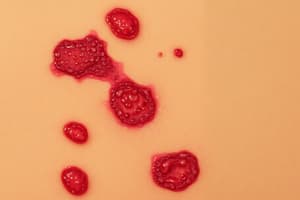Podcast
Questions and Answers
What is a bulla?
What is a bulla?
- A flat lesion not raised above the surrounding mucosa.
- A lesion characterized by redness and swelling.
- A fluid-filled lesion greater than 5mm in diameter. (correct)
- A small, raised, solid lesion under 5mm.
Which of the following best describes a macule?
Which of the following best describes a macule?
- A lesion that is raised and often red or inflamed.
- A round mass of tissue that can be confused with a bulla.
- A circumscribed discolored flat lesion not raised above the level of surrounding mucosa. (correct)
- An elevated structure filled with serum.
How does the size of a bulla compare to that of a macule?
How does the size of a bulla compare to that of a macule?
- A bulla is typically smaller than 5mm.
- A bulla and a macule are identical in size.
- A bulla is greater than 5mm in diameter, while a macule is not raised. (correct)
- A bulla is always greater than 10mm.
Which statement is false regarding a bulla?
Which statement is false regarding a bulla?
What feature distinguishes a macule from other lesion types?
What feature distinguishes a macule from other lesion types?
What is the definition of a nodule?
What is the definition of a nodule?
How is a mass characterized in terms of size?
How is a mass characterized in terms of size?
What defines an indurated lesion in the oral mucosa?
What defines an indurated lesion in the oral mucosa?
What describes an endophytic lesion?
What describes an endophytic lesion?
Which of the following statements is incorrect?
Which of the following statements is incorrect?
What is the primary characteristic of a fistula?
What is the primary characteristic of a fistula?
Which statement is true about indurated lesions?
Which statement is true about indurated lesions?
Which definition best fits a tumorlike structure?
Which definition best fits a tumorlike structure?
In the context of oral lesions, what does the term 'palpated' refer to?
In the context of oral lesions, what does the term 'palpated' refer to?
What is one potential implication of having a fistula?
What is one potential implication of having a fistula?
What are petechiae primarily caused by?
What are petechiae primarily caused by?
How is ecchymosis characterized in terms of size?
How is ecchymosis characterized in terms of size?
Which of the following describes the appearance of petechiae?
Which of the following describes the appearance of petechiae?
What distinguishes ecchymosis from petechiae?
What distinguishes ecchymosis from petechiae?
Which option is NOT a characteristic associated with petechiae?
Which option is NOT a characteristic associated with petechiae?
What does resolution refer to in microscopy?
What does resolution refer to in microscopy?
What is the role of the condenser in microscopy?
What is the role of the condenser in microscopy?
Which factor is most related to maximizing resolution?
Which factor is most related to maximizing resolution?
In microscopy, what does finer resolution allow a viewer to do?
In microscopy, what does finer resolution allow a viewer to do?
Why is light focus important in microscopy?
Why is light focus important in microscopy?
Flashcards are hidden until you start studying
Study Notes
Dermatological Lesions
- Bulla: A fluid-filled lesion larger than 5mm in diameter, indicating possible blistering.
- Macule: A flat, discolored lesion that is circumscribed and level with the surrounding mucosa.
- Nodule: An elevated, solid lesion that exceeds 5mm but is less than 2cm in diameter, suggesting a small growth or tumor.
- Mass: A solid lesion more than 2cm in diameter, often described as "tumor-like."
Additional Lesion Characteristics
- Endophytic: A lesion that grows inward into the underlying tissues, potentially invading them.
- Petechiae: Tiny red or purple spots that appear due to submucosal hemorrhage, often indicative of bleeding disorders.
- Ecchymosis: A larger macular area of hemorrhage that is greater than 2cm in diameter, resembling a bruise.
- Indurated: Referring to an oral mucosal lesion that feels firm upon palpation, possibly indicating inflammation or malignancy.
- Fistula: An abnormal connection between two epithelial-lined organs, usually resulting from disease or injury.
Other Important Concepts
- Resolution: The level of detail visible in a histological preparation or specimen, significant for diagnostic accuracy.
- Condenser: An optical component that focuses light onto a specimen, such as a histology slide, enhancing visibility for examination.
Studying That Suits You
Use AI to generate personalized quizzes and flashcards to suit your learning preferences.




